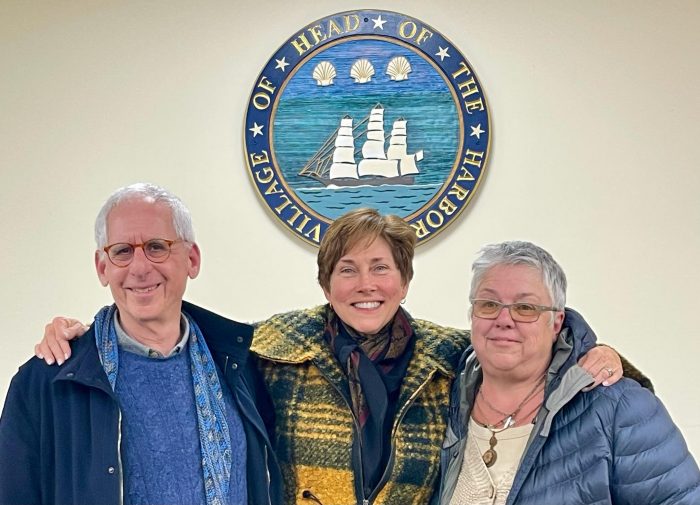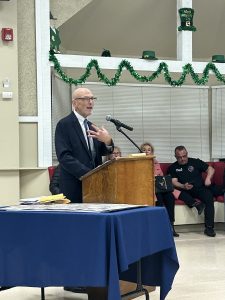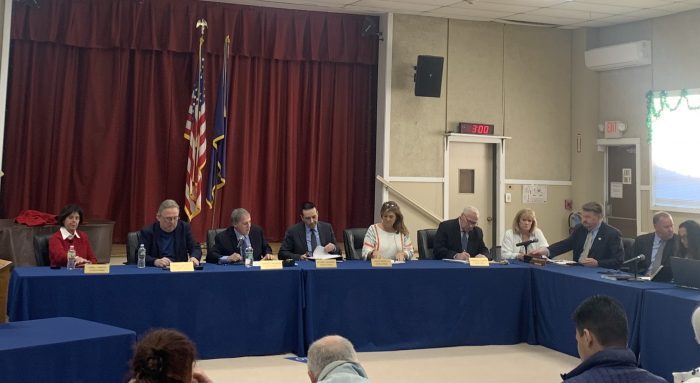A new Easter tradition
Thank you, Arts & Lifestyles Editor Heidi Sutton, for sharing the wonderful recipe for Apple Cinnamon French Toast Casserole (TBR News Media, “Let’s Eat,” Feb. 22). Every year for decades we have had ham, turkey or lamb for Easter. This year we decided to try something new. The Apple Cinnamon French Toast Casserole was the centerpiece of our first Easter brunch and it was fabulous. The recipe was easy to follow and the flavor was amazing. We have a new tradition!
Joan Dickinson
Lake Grove
Clarifying on climate, renewables and electric vehicles
In a letter appearing in the March 28 editions of TBR News Media, Mark Sertoff makes a number of highly dubious assertions.
To begin with he claims “there is no climate crisis” and that “thousands of scientists around the world concur.” Sounds impressive, but really it isn’t. There are well over 8 million scientists worldwide. In addition, scientists are not equal climate experts. What a geologist, astronomer or nuclear physicist thinks about global warming has little more weight than what you or I think. What does matter is what actively publishing climate scientists think. The answer is that close to 100 percent agree that human-caused global warming is occurring.
He claims Germany is backing off renewables because of “massive problems in reliability and cost.” This is simply untrue. On Jan. 3, Reuters reported that Germany’s power grid reached 55% renewable power last year, a rise of 6.6%. It’s aiming for 80% by 2030.
He’s worried about birds killed by wind turbines, as well as whales. I share his concern, but the fact is that by far the biggest human-related cause of bird mortality is collisions with buildings (Flaco the Owl being a recent sad example). As far as whales, entanglements in fishing gear and strikes by large ships are the leading human-related causes of whale deaths. And there’s no observational evidence linking whale deaths to offshore wind turbines, either in construction or operation.
Getting to the subject of electric buses he plays on fear. The fear of getting stuck in cold weather. The fear of explosions. Kings Park school district is currently purchasing propane-fueled buses. Propane can explode if not handled properly. As for diesel, studies have linked breathing diesel fumes to harmful effects on student respiratory and brain health, also decreased performance at school. And the range of electric school buses is more than adequate for our suburban Long Island districts, even in the dead of winter.
As far as the depreciation of electric vs. standard vehicles, the claim that “you can’t give away a used EV” is misleading, to say the least. The reason for higher depreciation is currently EVs cost more than standard vehicles to begin with. That’s likely to change in the near future. He omits to mention that electric school buses are significantly cheaper to operate.
It’s perfectly valid to disagree on the pace of transforming school bus fleets to electric. What’s not valid is climate change denialism and spreading misinformation about renewables.
David Friedman
St. James
The U.S. government needs to better protect its citizens
The U.S. Environmental Protection Agency has recently finalized the Comprehensive Asbestos Reporting Rule, and we must ask the question: Why has it taken so long? We know there are hundreds of toxic chemicals that lead to disease in this country, yet why is the U.S. one of the last to protect its own citizens?
Asbestos has been a known carcinogen for decades, causing over 40,000 deaths in the U.S. every year, and now our government is finally banning it. In 2016, during the Obama administration, the federal government passed legislation to update the 1976 Toxic Substances Control Act. However, why did it take 40 years to update a bill on toxic substances?
Twenty-two years ago, after my grandmother died from breast cancer, I founded the Community Health and Environment Coalition to address the high rate of cancer in the area. I wanted to know why it was happening and how to prevent it. Community members, elected officials and health professionals challenged the NYS Department of Health to do more. The Health Department did this by launching an investigation that left us with more questions than answers. During the investigation, most residents expressed concerns about our environment, particularly our water. Today we have identified toxic chemicals in our water including PFAS “forever chemicals” and 1,4-dioxane.
Decades of illegal dumping, military and industrial use of toxic chemicals dumped in the ground and now-banned pesticides have contributed to our long toxic chemical legacy. We are finally seeing some progress after years of grassroots environmental advocacy and government policy proactively holding those responsible, but more must be done.
As the chemical industry continues to exert power over the government, we must understand that cheap utilitarian toxic chemicals may seem helpful at first, but the long-term health effects may negate any cost savings and may put our lives at risk.
It’s been over 20 years since the Sept. 11, 2001, attacks that killed thousands of people. Since then, many first responders have suffered delayed symptoms and continue to lose their lives due to exposure to toxic chemicals. Now that we better understand the long-term health effects of toxic exposure, we must hold those responsible and insist that they do more to protect lives.
Sarah Anker
Sarah Anker (D) is a former Suffolk County legislator and is running for New York State Senate in District 1.
Northville is potentially a local treasure
Monday evening, March 25, I attended a gathering.
It was not intended to be a gathering. It was intended to be a hearing, and the hearing was about Northville Industries proposal to put either warehouses (plan A) or apartments (plan B) on its Belle Mead Road property.
Only local residents were notified of this “hearing” but apparently these residents felt strongly enough to enlist friends and relatives from Northern Brookhaven to attend. The “hearing” was so well attended that it had to be postponed and relocated.
Let me state that both options are terrible choices. Plan A comes with immense truck traffic, while plan B comes with dense-pack zoning and IDA funding.
What is IDA funding you might ask? That’s when the town gives away taxpayer money to subsidize private development. This means incredibly low taxes for the developer for up to 15 years and then a gradual increase thereafter. All the services that you and I receive for our taxes will be rendered, but at your and my expense.
But here’s the thing. The Northville property is potentially a local treasure — this is not hyperbole. The future of transportation, including railroad, and electrical generation is with hydrogen.
We cannot go green enough without it. Foreign countries are building hydrogen trains and are putting them on the rails. Hydrogen is a solution to our truly poor-quality railroad transportation. The European market is investing $5 billion in a Swedish steel plant. The electricity for the plant will come from hydrogen.
But where do you store the hydrogen?
Well, the pipeline rights-of-way are already in place for Northville. This can be done safely and it can be an enormous boon to our Brookhaven Town, Suffolk County and even New York State economies (Alstom, a subsidiary of GE, manufactures hydrogen trains in Plattsburgh). The alternative is that we purchase trains in America from foreign countries.
The vacant and underused parts of the Northville property must be protected for future use to meet New York’s climate standards.
Please come to the new hearing and tell your representatives that both plan A and plan B are unacceptable.
Bruce Miller
Port Jefferson
Embracing 3V schools reconfiguration
The Three Village Central School District has finally made the decision to move into the 21st century and reconfigure our schools to a middle school model. This is a move that is decades overdue and was overwhelmingly supported by students, staff and the community at large.
An Opinion piece published in the March 14 edition [“Preserving what works in 3V school district”] is a direct contradiction to all that this long-awaited, and very necessary, reconfiguration represents. Anthony Dattero, a district guidance counselor and author of this piece, has stated his dissent regarding this move citing the “history” and “uniqueness” of the district. To that I must say that there is a stark difference between one of a kind and one left behind.
As a dual certified teacher, licensed social worker and former guidance counselor, I simply cannot fathom why the benefits of this monumental change are not obvious to everyone who is committed to the growth and success of all of our students. And as a Ward Melville alumni and parent of a Three Village student I am thrilled for the students that will bask in the new opportunities that the reconfiguration will offer.
Sixth graders will now have access to the study of a foreign language as well as an array of academics that peers in every other district in New York — except for one —- have. Ninth graders will finally, finally be housed in a high school as high schoolers. No longer will they be subjected to bus rides for upper-level courses and JV athletics.
Gone will be the limited elective choices in art, music, technology, etc., as well as sacrificing these opportunities due to scheduling conflicts. This reconfiguration is akin to hitting the refresh button on a page long left with the cursor blinking.
In Dattero’s Opinion piece and his many public comments at Board of Education meetings, he has claimed that the district did not do its due diligence and that the 100-or-so people that he has spoken to are now questioning the changes that are indeed coming. He doesn’t understand why the district is in such a hurry to reconfigure something that “isn’t broken.”
I counter his position with my own experiences speaking to those in Three Village and several other districts. Fellow 3V members are excited for their children’s new opportunities and cannot believe it has taken so long. Those outside of our community are stunned that our antiquated system still exists as no other ninth graders on Long Island are considered “junior high school” students. If we are hurrying this through, then it’s the quickest two-decade race I have ever observed at a sloth-like pace.
I am not always a fan of the decisions in this district, just ask Superintendent Kevin Scanlon, but my family has been a part of Three Village my whole life. My mother spent nearly three decades teaching at Ward Melville, my sister and I are graduates, and my daughter will be too. I have seen this place ebb and flow through good and bad, and we have been calling for this change for way too long. The community has spoken, and the time has finally arrived. Middle school here we come!
Stefanie Werner
East Setauket
Setbacks and uncertainty for Port Jeff LIRR electrification
There is even more bad news for those who support the $3.5 billion MTA Port Jefferson Branch Long Island Rail Road electrification project.
It is clear that the MTA for decades has never been serious about supporting this project. The project was not included in the March 11 announcement from U.S. Secretary of Transportation Pete Buttigieg [D] concerning President Joe Biden’s [D] FY25 budget request under the Annual Report on Funding Recommendations Fiscal Year 2025 Capital Investment Grants New Starts Core Capacity Program and Expedited Project Delivery Pilot Program for the Federal Transit Administration. This would have been the federal funding source to finance these projects.
To date, neither MTA Chairman Janno Lieber, NYC Transit President Richard Davey, New York Sens. Chuck Schumer and Kirsten Gillibrand, Gov. Kathy Hochul and NYC Mayor Eric Adams, have never been on board for electrification of the Port Jefferson Branch line. You will know within nine months if the MTA is serious about advancing this project. Funding would have to be included in the next MTA $51 billion or more 2025-2029 Five Year Capital Plan. It has to be adopted by Jan. 1, 2025.
Larry Penner
Great Neck

















